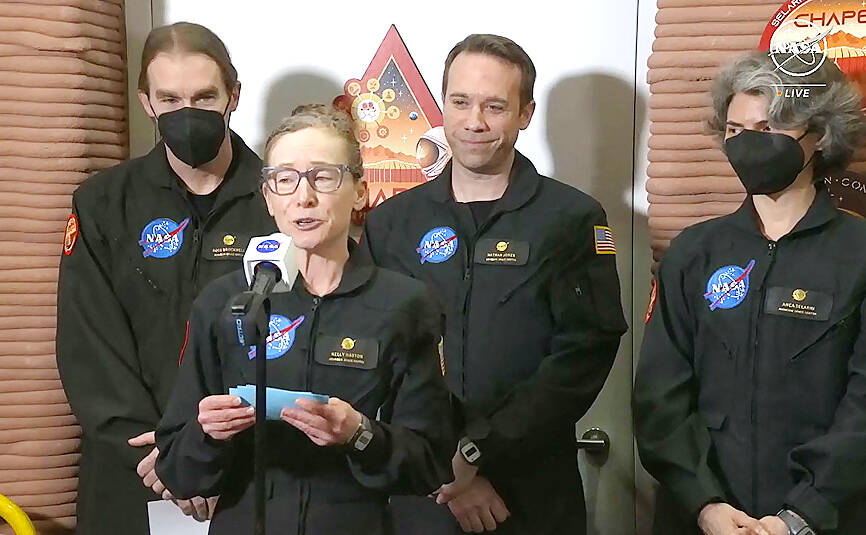The NASA astronaut knocks loudly three times on a what appears to be a nondescript door, and calls cheerfully: “You ready to come out?”
The reply is inaudible, but beneath his mask he appears to be grinning as he yanks the door open and four scientists who have spent a year away from all other human contact, simulating a mission to Mars, spill out to cheers and applause.
Anca Selariu, Ross Brockwell, Nathan Jones and team leader Kelly Haston have spent the past 378 days sealed inside a “Martian” habitat in Houston, Texas, as part of NASA’s research into what it would take to put humans on the Red Planet.

Photo: AFP / NASA TV
They have been growing vegetables, conducting “Marswalks,” and operating under what NASA terms “additional stressors,” such as communication delays with “Earth,” isolation and confinement. It is the kind of experience that would make anyone who lived through COVID-19 lockdowns shudder — but all four were beaming on Saturday as they re-emerged, their hair slightly more unruly and their emotion apparent.
“Hello. It’s actually so wonderful just to be able to say hello to you,” Haston, a biologist, said with a laugh.
“I really hope I don’t cry standing up here in front of all of you,” Jones, an emergency room doctor, said as he took to the microphone — and nearly doing just that several moments later as he spotted his wife in the crowd.
The habitat, dubbed Mars Dune Alpha, is a 3D printed 160m2 facility, complete with bedrooms, a gym, common areas and a vertical farm to grow food. An outdoor area, separated by an airlock, is filled with red sand and is where the team donned suits to conduct their “Marswalks,” although it is still covered rather than being open air.
“They have spent more than a year in this habitat conducting crucial science, most of it nutrition-based and how that impacts their performance ... as we prepare to send people on to the Red Planet,” said Steve Koerner, deputy director at NASA’s Johnson Space Center. “I’m very appreciative.”
This mission is the first of a series of three planned by NASA, grouped under the title Crew Health and Performance Exploration Analog.

Kehinde Sanni spends his days smoothing out dents and repainting scratched bumpers in a modest autobody shop in Lagos. He has never left Nigeria, yet he speaks glowingly of Burkina Faso military leader Ibrahim Traore. “Nigeria needs someone like Ibrahim Traore of Burkina Faso. He is doing well for his country,” Sanni said. His admiration is shaped by a steady stream of viral videos, memes and social media posts — many misleading or outright false — portraying Traore as a fearless reformer who defied Western powers and reclaimed his country’s dignity. The Burkinabe strongman swept into power following a coup in September 2022

‘FRAGMENTING’: British politics have for a long time been dominated by the Labor Party and the Tories, but polls suggest that Reform now poses a significant challenge Hard-right upstarts Reform UK snatched a parliamentary seat from British Prime Minister Keir Starmer’s Labor Party yesterday in local elections that dealt a blow to the UK’s two establishment parties. Reform, led by anti-immigrant firebrand Nigel Farage, won the by-election in Runcorn and Helsby in northwest England by just six votes, as it picked up gains in other localities, including one mayoralty. The group’s strong showing continues momentum it built up at last year’s general election and appears to confirm a trend that the UK is entering an era of multi-party politics. “For the movement, for the party it’s a very, very big

A new online voting system aimed at boosting turnout among the Philippines’ millions of overseas workers ahead of Monday’s mid-term elections has been marked by confusion and fears of disenfranchisement. Thousands of overseas Filipino workers have already cast their ballots in the race dominated by a bitter feud between President Ferdinand Marcos Jr and his impeached vice president, Sara Duterte. While official turnout figures are not yet publicly available, data from the Philippine Commission on Elections (COMELEC) showed that at least 134,000 of the 1.22 million registered overseas voters have signed up for the new online system, which opened on April 13. However,

ENTERTAINMENT: Rio officials have a history of organizing massive concerts on Copacabana Beach, with Madonna’s show drawing about 1.6 million fans last year Lady Gaga on Saturday night gave a free concert in front of 2 million fans who poured onto Copacabana Beach in Rio de Janeiro for the biggest show of her career. “Tonight, we’re making history... Thank you for making history with me,” Lady Gaga told a screaming crowd. The Mother Monster, as she is known, started the show at about 10:10pm local time with her 2011 song Bloody Mary. Cries of joy rose from the tightly packed fans who sang and danced shoulder-to-shoulder on the vast stretch of sand. Concert organizers said 2.1 million people attended the show. Lady Gaga